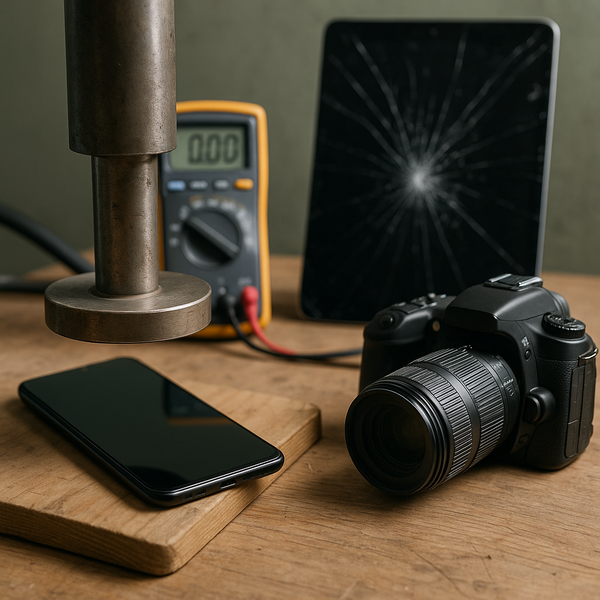
In a world where our lives revolve around our electronic devices, their ability to withstand the bumps and drops of daily life is crucial. Gadget durability tests have become standard practice, providing consumers with insights into how well their smartphones, tablets, and laptops might survive accidental encounters with water, hard surfaces, or extreme conditions. Understanding these tests helps you make informed decisions about the resilience of the tech you rely on every day.
Why Durability Testing Matters
Gadget durability isn't just a buzzword; it's a critical factor in the longevity and reliability of our devices. As technology becomes more integrated into every aspect of our lives, from outdoor adventures to demanding work environments, the risk of accidental damage increases. Manufacturers conduct rigorous tests to ensure their products can withstand expected use, and often, unexpected mishaps. For consumers, understanding these tests demystifies the claims made by companies and provides a clearer picture of a gadget's real-world toughness. A device that performs well in durability tests might save you from costly repairs or premature replacements.
Common Types of Durability Tests
Durability testing encompasses a variety of simulations designed to mimic the stresses a device might face. Some tests are standardized, while others are proprietary to specific manufacturers or independent reviewers.
Drop Tests
Perhaps the most common and visually dramatic test, drop tests simulate accidental falls. Devices are dropped from varying heights onto different surfaces (like concrete, steel, or wood) and from different orientations (face down, edge down, corner down). The height and surface material significantly impact the severity of the test. While some tests follow specific standards like MIL-STD-810G, many are performed by reviewers simply dropping the device from pocket or waist height. The goal is to assess damage to the screen, body, and internal components.
Water Resistance Tests
Water is a common enemy of electronics. Water resistance tests measure a device's ability to withstand splashes, rain, or even submersion. The most widely recognized standard is the IP (Ingress Protection) rating. An IP rating consists of two digits: the first indicates protection against solid particles (like dust), and the second indicates protection against liquids. For example, IP67 means dust tight (6) and protected against temporary immersion in water up to 1 meter for 30 minutes (7). IP68 typically allows for deeper or longer submersion, although the exact depth and time can vary by manufacturer. Tests involve spraying the device with water jets or submerging it in water under controlled conditions.
Scratch Tests
Screen scratches are a common complaint. Scratch tests use materials of varying hardness, often using the Mohs hardness scale, to determine how easily a screen or device body can be scratched. Everyday items like keys and coins are also used in informal tests to show real-world vulnerability. While screen protectors offer an extra layer of defense, the inherent scratch resistance of the screen material itself is tested.
Temperature and Humidity Tests
Extreme temperatures or fluctuating humidity can damage components and affect performance. Devices are subjected to hot, cold, humid, or dry conditions in environmental chambers to ensure they can operate within their specified temperature ranges and withstand storage or transport in adverse climates. These tests are particularly important for devices used outdoors or in industrial settings.
Bend Tests
Bend tests assess a device's structural integrity when subjected to bending force, often simulating pressure applied when carrying a phone in a tight pocket. This test gained prominence after certain large smartphones exhibited bending issues. Devices are placed in a machine that applies pressure from different angles to see if the body flexes, warps, or breaks.
Tumble Tests
Tumble tests are used for smaller, rugged devices. The device is placed in a rotating drum with obstacles, simulating repeated drops and tumbles from a short height, such as might occur in a construction environment or warehouse. This provides a measure of overall structural resilience against multiple impacts.
Understanding Standards and Ratings
Many manufacturers refer to standards like IP ratings or MIL-STD-810G to quantify durability. MIL-STD-810G is a U.S. military standard that covers a wide range of environmental tests, including drops, vibration, shock, temperature extremes, altitude, and humidity. While a device claiming MIL-STD-810G compliance has passed some of these tests, it's important to note that manufacturers can choose which specific tests they perform, and the standard doesn't necessarily guarantee invincibility. Always look for the specific tests passed rather than just the general claim.
What Durability Tests Mean for You
For consumers, durability test results should be part of your decision-making process, especially if you have an active lifestyle or work in demanding conditions. A high IP rating offers peace of mind around water, while good performance in drop tests suggests the device can survive everyday accidents. However, remember that 'durability' is not 'indestructibility'. These tests demonstrate resilience under specific, controlled conditions. Real-world damage can still occur, and warranties often do not cover accidental damage, even on ruggedized devices. Consider your own usage habits and environment when evaluating test results.
Gadget durability tests offer valuable insights into how well our beloved devices can withstand the stresses of daily life. While they aren't a guarantee against all potential damage, understanding the types of tests performed and the meaning of standards like IP ratings or MIL-STD gives you a better idea of a gadget's potential resilience. By paying attention to durability information, you can choose devices that are better suited to your needs and hopefully enjoy them for longer, reducing the need for repairs or replacements.

